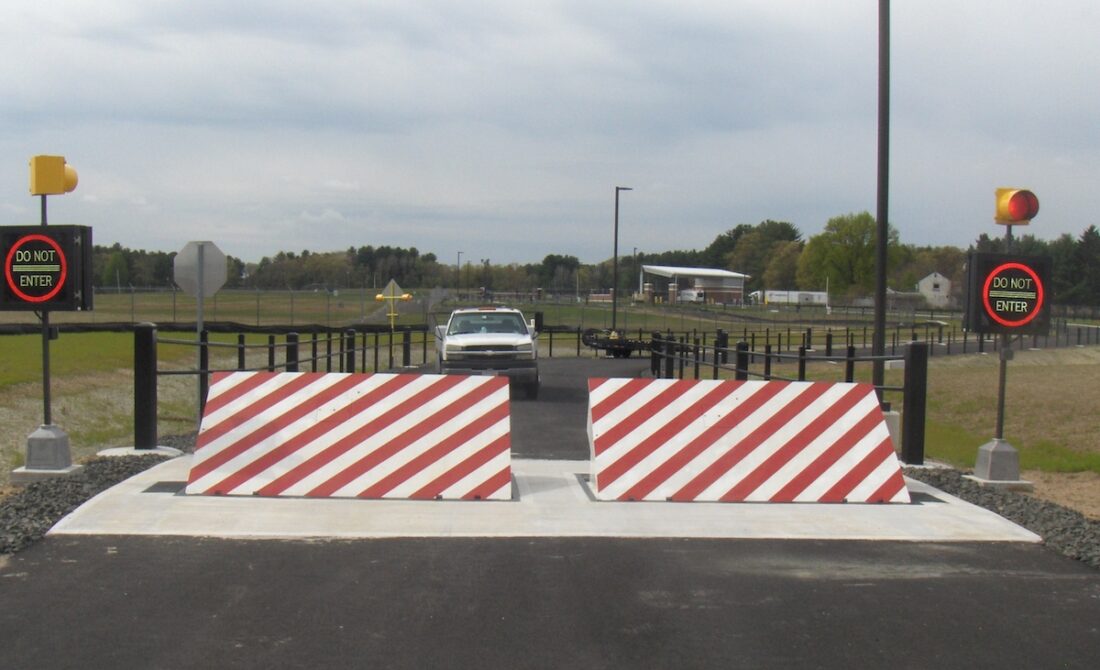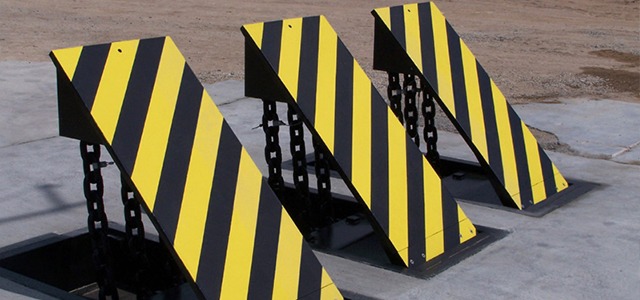Fascination About Wedge Barriers
Get This Report about Wedge Barriers
Table of ContentsThe smart Trick of Wedge Barriers That Nobody is Talking AboutWedge Barriers Can Be Fun For Everyone


18 might be done a lot more swiftly, easily, and price successfully. FIG. In particular personifications, the anchor 30 might be a steel structure including plates, light beams(e. g., I-beams ), and/or other frameworks that are protected within the foundation 14, which might be concrete. At the surface 12, a top side 28 of the anchor 30 might go to least partially exposed
, therefore enabling the accessory of the obstacle 10 to the support 30. g., threaded openings)in one or even more beams or plates of the anchor 30 might be exposed to the surface 12. In this fashion, bolts 32 or various other mechanical bolts might be used to safeguard the barrier 10 to the anchor 30. As the obstacle 10 is placed to the surface 12 of the structure 14, collection of particles and various other material underneath the obstacle might be lowered, and parts of the bather 10 may not be revealed to listed below quality settings. As suggested by recommendation character 52, the training system 50 consists of parts got rid of beneath the wedge plate 16. For instance, the parts 52 under the wedge plate 16 might consist of an electromechanical actuator, a camera, several web cam surfaces, and so forth. In addition, the training device 50 consists of a springtime setting up 54
The springtime rod 58 is coupled to a cam(e. g., web cam 80 revealed in FIG. 4) of the training system 50. The springtimes 60 disposed concerning the springtime rod 58 are kept in compression by springtime supports 62, including a fixed spring support 64. That is, the set springtime assistance 64 is fixed relative to the foundation 14 and the remainder of the bather 10.
Wedge Barriers Fundamentals Explained
g., springtime assistance 65 )might be repaired to completion of the spring pole 58 to make it possible for compression of the springtimes 60. As the springtimes 60 are compressed in between the spring sustains 62, the spring setting up 54 generates a pressure acting on the camera paired to the spring rod 58 in an instructions 66. The continuing to be force applied to
the cam web cam deploy release wedge plate 16 may might provided given an electromechanical actuator 84 or other various other. Because of this, the springtime setting up 54 and the actuator 84(e. g., electromechanical actuator)might operate with each other to translate the webcam and raise the wedge plate 16.
As pointed out above, the springtime setting up 54 puts in a constant force on the camera, while the electromechanical actuator may be controlled to put in a variable force on the webcam, therefore making it possible for the training and decreasing( i. e., deploying and pulling back )of the wedge plate 16. In particular embodiments, the constant force used by the spring assembly 54 might be flexible. g., electromechanical actuator) is disabled. As will be valued, the spring assembly 54 might be covered and safeguarded from particles or other components by a cover plate(e. g., cover plate 68 received FIG. 4) that might be substantially flush with the raised surface 38 of the foundation 14. As pointed out above, in the deployed setting, the wedge plate 16 serves to block accessibility or travel beyond the obstacle 10. As an example, the obstacle 10(e. g., the wedge plate 16 )may block pedestrians or automobiles from accessing a residential or commercial property or pathway. As talked about over, the obstacle 10 is connected to the anchor 30 secured within the structure 14,

front braces 71. Because of this, the linkage settings up 72 might pivot and revolve to make it possible for the collapse and extension of the linkage assemblies 72 during retraction and deployment of the bather 10. The link assemblies 72 cause motion of the wedge plate 16 to be limited. As an example, if a car is taking a trip in the direction of the released wedge plate 16(e. As an example, in one circumstance, the safety legs 86 may be extended duringupkeep of the barrier 10. When the security legs 86 are released, the safety legs 86 sustain the weight of the wedge plate 16 versus the surface 12. Consequently, the training mechanism 50 might be deactivated, serviced, removed, replaced, etc. FIG. 5 is partial perspective view of a personification of the surface-mounted wedge-style barrier 10, illustrating the web cam 80 and the camera surfaces 82 of the lifting device 50. Especially, two camera surface areas 82, which are described as lower webcam surfaces 83, are placed listed below the camera 80. The reduced web cam surface areas 83 may be fixed to the surface 12 (e. For instance, the reduced webcam surface areas 83 and the mounting plate 85 may develop a solitary piece that is secured to the support 30 by bolts or other mechanical bolts. Furthermore, 2 camera surface areas 82, which are described as top web cam surfaces 87, are placed above the cam 80 and coupled to (e. In various other embodiments, stepping in layers or plates might be positioned in between the surface 12 and the reduced cam surface areas 83 and/or the wedge plate 16 and the top cam surface areas 87 As mentioned above, the webcam
80 translates along the web cam surface areas 82 when the wedge plate 16 is lifted from the pulled back placement to the deployed setting. In addition, as pointed out above, the spring assembly 54 (see FIG. 3 )might give a pressure acting on the additional info camera 80 in the instructions 102 using springtime rod 58, which might lower the force the electromechanical actuator 84 is called for to put on the webcam 80 in order to activate and raise the wedge plate 16. 1 )to the released placement(see FIG. 4). As shown, the webcam check my site 80 consists of track wheels 104(e. g., rollers), which get in touch with and convert along the cam surfaces 82 during operation.